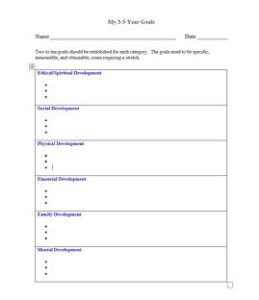 If you don't know where you are going, you will never get there.
If you don't know where you are going, you will never get there.
Introduction
One of the most important, and often neglected, aspects of retirement planning is goal setting. Many people are used to establishing goals within their careers either informally or through structured company-sponsored performance management scorecard or management by objectives (MBO) processes. However, these same people often approach retirement with little or no advanced planning. They are eager to leave behind the highly structured and controlled eight-to-five company environment for a relaxed laissez-faire lifestyle. Their feeling is that “I’ll just chill out, approach one day at a time, and do my own thing”. Although this may work for awhile, there usually comes a time when they feel that a greater purpose and direction is needed in the second half of their life. This is where goal setting comes in.
I’m not suggesting that one should wait until well into retirement before setting goals. In fact, retirement goals should be established months or years prior to deciding to retire. These goals should be evaluated against work-related goals to assure that the retirement goals provide significantly greater value and satisfaction. Value is based on an individual perspective of the importance of various items in one’s life including achievement, creativity, knowledge, wealth, adventure, health/physical condition, skill, public service, relationships/friendships, philanthropy, recognition, power, religion, etc.
A Sense of Purpose
According to the following text from a recent AARP article, it's good to have a sense of purpose in your life.
What does it mean to have a sense of purpose, and where do we find it? Purpose means feeling that we have goals, and our lives have direction. It’s the feeling that we matter — whether to friends and family, colleagues, our communities, even the pets we care for. Purpose can come from many sources, including work, a creative project, learning a new skill, tending a garden, volunteering for a cause, or being with family. Imagine what will feel purposeful in your life and start creating the conditions for it.
Debra Whitman, author of The Second Fifty, learned that a sense of purpose doesn’t just feel good, it extends our lives. Purpose is associated with healthy behaviors such as exercise and preventative healthcare; lower risk of cardiovascular disease and cognitive impairment; and reduced risk of death from any cause.
Vision Board
 Once you have established your goals, both physical and spiritual, you may which to utilize a Vision Board to help you achieve your goals.
Once you have established your goals, both physical and spiritual, you may which to utilize a Vision Board to help you achieve your goals.
A vision board is a visualization tool that refers to a board containing words, pictures and images that represent your goals and dreams. It helps you connect from your current situation to your more satisfying future condition. It is a collection of images that represent the things that you want in life. The images make you feel good and prompt you to act.
Images can be obtained by scrolling through magazines, google searches, and other ways. These images are then cut out or copied and arranged onto a vision board. The board can be a poster board, cork board, a series of PowerPoint frames or other media. Then, locate the vision board in a place where you’ll be able to see it daily.
Visualizing your goals provides another step in helping you to successfully achieve them. It provides further motivation and inspiration helping your dreams come true.
Dream List
Retirement goal setting starts with a “dream list”. A dream list is a composition of unconstrained life events that you would contemplate if you had no restrictions relative to finances, physical condition, mental ability, etc. The dream list assumes that you can do anything that you want to do with no restrictions. Once a retirement dream list is established, the goal-setting process can begin. Goals provide the underpinning for achieving and living your dreams. They may not all be fully achievable, but they set a direction and purpose that gets you on course toward an improved and possibly superior retirement lifestyle.
Goal Categories
 A comprehensive set of goals generally includes the following categories: ethical/spiritual development, social development, physical development, financial development, family development, and mental development.
A comprehensive set of goals generally includes the following categories: ethical/spiritual development, social development, physical development, financial development, family development, and mental development.
- Ethical/Spiritual Development – Goals in this category involve seeking higher standards of conduct, morality and spirituality. They may include religion study/growth and goals in serving others and/or a divine being.
- Social Development – Goals that involve the building and strengthening of relationships, friendships, and social conduct. Included are goals relating to social activities, social development and community service.
- Physical Development – Goals related to physical health and appearance. Included are goals relating to eating habits, weight reduction/maintenance, exercise, sports participation, general health, physical appearance, and alcohol/substance use.
- Financial Development – Goals relating to retirement income/expenses, financial planning/preparedness and overall financial health. This includes goals relating to net worth (assets/liabilities), investments, income, budgeting, debt reduction, insurance (life, medical, vision, dental), tax planning, estate planning, etc.
- Family Development – Goals that involving relationships with spouse and other family members. These include the planning of special times and events for interfacing with family members, building/strengthening relationships and creating greater levels of respect and understanding.
- Mental Development – Goals that challenge the mind and increase understanding of the world. Included are goals for building/maintaining mental acuity, expanding the mind, increasing mind/body coordination, learning a new skill, achieving new experiences, obtaining formal classroom training/education, developing an increased understanding and appreciation of music, the arts and sciences, etc.
Two to ten goals should be established for each category. The goals should be for a three-to-five-year timeframe. They need to be specific, measurable and obtainable, some requiring a stretch. Once goals are set, strategies and detailed objectives/steps to obtain them should be developed. One of these strategies should be the timing of retirement (i.e., when one begins to address retirement goals). After the start of retirement, periodically, at least annually, goals should be reviewed and adjusted to account for progress, lessons learned and changing values.
Click on the following link to obtain a sample form for use in setting goals: Goal Setting Form
 If you don't know where you are going, you will never get there.
If you don't know where you are going, you will never get there.